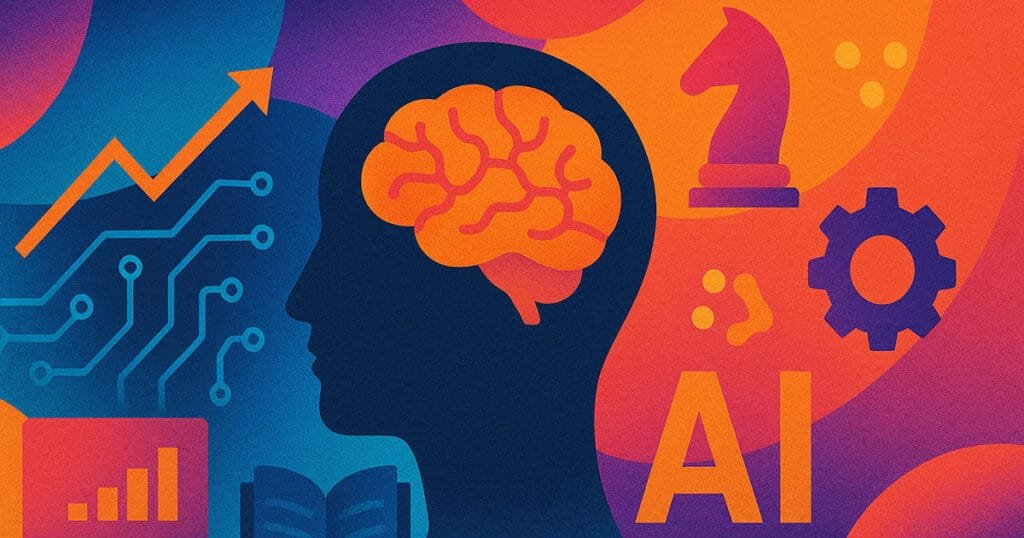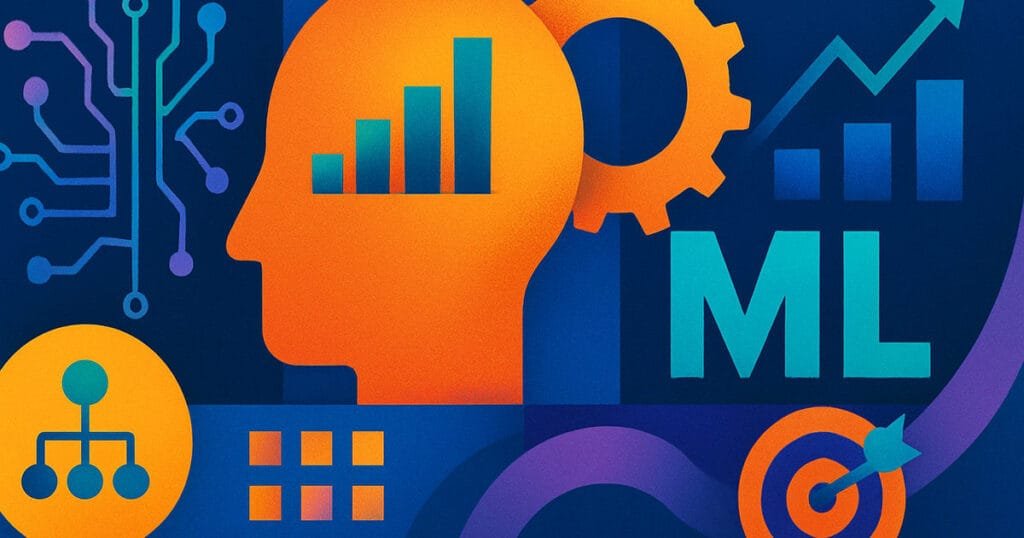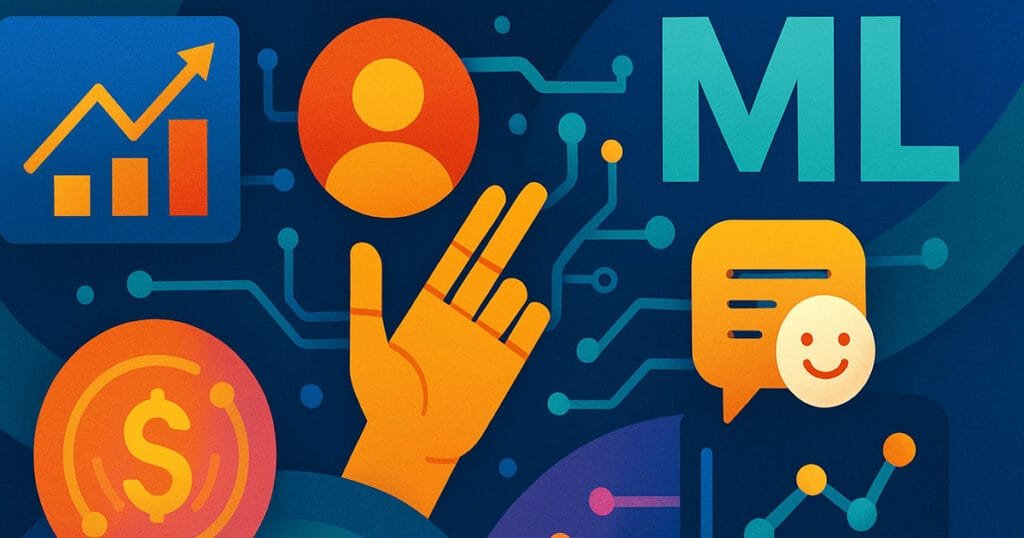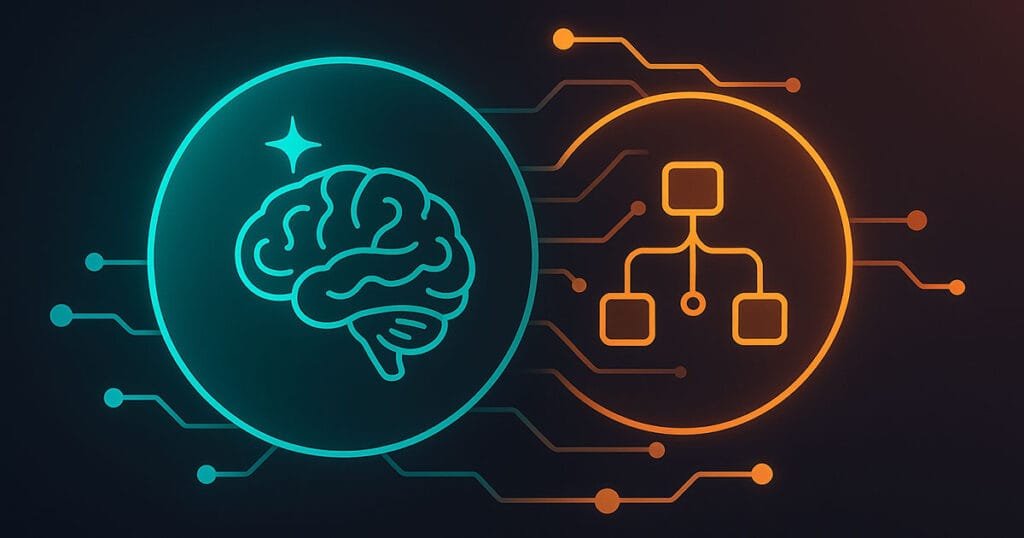Keen to harness the power of cutting-edge technology but puzzled by technical jargon? You’re not alone. Many business leaders struggle to tell the difference between artificial intelligence and machine learning. Yet understanding this distinction is vital for making smart investment choices and getting the most from these game-changing technologies.
What’s the Real Difference Between AI and ML?
Artificial intelligence and machine learning aren’t the same thing—though they’re often used as if they were. Think of artificial intelligence as the big picture: it’s about creating computers that can mimic human intelligence. Machine learning is just one way to achieve this goal.
“AI represents the broad, ambitious concept of creating machines that can simulate human intelligence across various tasks,” explains Dr. Sarah Chen, AI researcher at Cambridge University. “Machine learning, however, is a specific approach within AI that focuses on systems learning automatically from data.”
This difference matters because it affects your technology choices, project planning, resource allocation, and overall strategy. When you understand what each term truly means, you make better decisions about which solutions fit your specific business needs.

Understanding Artificial Intelligence: Beyond the Robots
Artificial intelligence isn’t just about walking, talking robots. It’s a wide field of science and engineering aimed at building technology that can simulate human intelligence.
AI systems aim to:
- Solve problems
- Make decisions
- Understand their environment
- Learn and improve
- Sometimes show creativity
The technology works toward creating “smart machines” that can sense what’s happening around them, understand information, act on that information, and learn from the results, similar to how humans operate.
Think of AI not as a single tool but as a collection of different technologies working together. These include machine learning but also other methods like rule-based systems, natural language processing, computer vision, and robotics.
For your business, AI is best viewed in terms of what it can do—the tasks it can perform that would normally need human intelligence or that involve processing huge amounts of data. This practical view helps you focus on the actual benefits: automating repetitive tasks, improving decision-making, boosting operational efficiency, and creating better customer experiences.
Machine Learning Explained: The Data-Driven Engine
Machine learning is a branch of artificial intelligence with one defining feature: it allows computers to learn from data without being explicitly programmed for every situation.
Unlike traditional software where programmers write specific rules for every scenario, ML systems improve their performance on specific tasks as they process more data. They recognise patterns and make predictions based on what they’ve “learned” during training.
“Machine learning is like teaching by example rather than instruction,” says Tom Harris, Chief Data Officer at Retail Analytics Ltd. “Instead of programming rules, you feed the system examples, and it figures out the patterns itself.”
Data quality is crucial for machine learning success. ML models are only as good as the data used to train them. This means your business needs a strong data strategy, including good practices for collecting, cleaning, and managing data before diving into ML projects.
Machine learning comes in several flavours:
- Supervised learning: The system learns from labelled examples (like emails marked as “spam” or “not spam”)
- Unsupervised learning: It discovers hidden patterns in unlabelled data (like grouping customers based on buying habits)
- Reinforcement learning: The system learns through trial and error (like a computer learning to play chess)
Unlike the broader goal of AI, machine learning focuses on becoming very good at specific tasks by learning from data. This means your ML projects should have clearly defined objectives. A model trained to spot credit card fraud won’t suddenly be able to generate marketing copy – you need different models for different jobs.

How ML Powers Today’s AI
Machine learning isn’t separate from artificial intelligence—it’s the main method used to achieve AI capabilities in today’s business world. ML provides the practical tools that power many modern AI systems.
This relationship explains why the terms are often confused. Many AI applications that businesses use today rely heavily on ML’s ability to learn from vast amounts of data. Features like understanding human language, recognising objects in images, spotting unusual patterns, and making accurate predictions are typically powered by machine learning models.
Consider a self-driving car system. The overall AI needs to sense its environment, make decisions, and control the vehicle. ML might handle specific tasks within this system:
- Using computer vision to recognise pedestrians and traffic signs
- Predicting what other drivers might do based on learned patterns
- Finding the best route by analysing traffic data
The main AI system coordinates these ML components alongside other elements like safety rules to achieve the goal of safe driving.
The rise of ML in today’s AI landscape reflects an important shift in the field. While AI has been around since the 1950s, early approaches focused more on logic and explicit rules. The recent explosion in available data and computing power has fuelled huge advances in ML techniques, especially deep learning (a complex form of ML using neural networks).
These advances have led to breakthroughs in areas that were once major challenges for AI, such as accurate image recognition and natural language understanding. As a result, many of the most valuable AI applications used by businesses today are fundamentally driven by machine learning.
AI Without ML: Rule-Based Systems Still Matter
While machine learning dominates today’s AI scene, it’s worth noting that not all artificial intelligence relies on learning from data. Some AI systems use more traditional approaches that don’t need ML at all.
Rule-based systems and expert systems are classic examples. These operate using pre-defined “if-then” rules crafted by human experts. Examples include:
- Basic chatbots that follow set conversation paths
- Simple process automation that follows strict step sequences
- Some medical diagnosis tools that use expert-created decision trees
Another category includes search algorithms and optimisation techniques. These solve problems by systematically exploring possible solutions according to defined rules. Examples include:
- GPS navigation finding the best route between points
- Scheduling systems creating efficient timetables
These approaches have advantages in certain situations. Rule-based systems are often more transparent—you can easily trace why they made specific decisions. This clarity can be crucial in regulated industries or safety-critical applications where understanding the decision process matters more than raw performance.

Machine Learning at Work: Real Business Applications
Machine learning drives many of the most transformative AI applications creating business value today. Here are key areas where ML makes a tangible impact:
Predictive Analytics & Forecasting
ML excels at using historical data to predict future outcomes. Businesses use this for:
- Forecasting sales based on past performance and market trends
- Predicting which customers might leave (churn)
- Optimising inventory by forecasting demand
- Scheduling preventive maintenance before equipment fails
For example, British retailer Marks & Spencer uses ML-powered demand forecasting to reduce food waste by accurately predicting sales of perishable items.
Personalisation & Recommendation
ML algorithms analyse individual behaviour to deliver tailored experiences:
- Streaming services suggesting content based on viewing history
- Online shops recommending products related to past purchases
- Marketing platforms delivering personalised campaigns
These systems significantly boost engagement and sales. According to research by Boston Consulting Group, companies using advanced personalisation see revenue increases of 6-10%.
Fraud Detection & Risk Management
ML models spot subtle patterns that might indicate fraud or risk:
- Banks identifying unusual credit card transactions
- Cybersecurity systems flagging suspicious network activity
- Financial institutions assessing loan application risks
UK banking group Lloyds reported a 15% improvement in fraud detection after implementing ML systems.
Customer Service & Sentiment Analysis
Natural Language Processing (often using ML) helps systems understand human language:
- AI-powered chatbots handling routine customer questions
- Systems analysing customer reviews and social media comments
These tools improve customer satisfaction while reducing support costs.
Process Automation & Optimisation
ML can automate complex tasks and find more efficient ways to operate:
- Extracting data from invoices and forms
- Optimising delivery routes based on traffic and historical data
- Automating parts of recruitment like CV screening
The real value of ML comes from creating effective data-driven decision loops. ML algorithms analyse data to generate insights, which then inform decisions or trigger actions. For instance, a predictive maintenance model is only useful if it leads to scheduling actual maintenance.
Successful ML implementation requires thinking beyond the algorithm itself to consider how ML-generated insights will be used in real-world situations to achieve business outcomes.

AI vs ML: A Quick Comparison Guide
To clarify the relationship between artificial intelligence and machine learning, here’s a direct comparison across key areas:
Primary Goal
- AI: Create machines that simulate human intelligence and cognitive functions
- ML: Enable systems to learn from data to perform specific tasks accurately
Scope
- AI: Broad umbrella term covering various methods and technologies
- ML: Narrower focus on algorithms and models that learn from data
Approach
- AI: Uses diverse techniques including ML, rule-based systems, logic, search algorithms
- ML: Primarily relies on statistical methods to identify patterns and make predictions
Data Dependency
- AI: Variable requirements depending on the approach
- ML: High dependency on data for training and improvement
This comparison shows that “intelligence” in AI and ML exists on a spectrum rather than being all-or-nothing. Not every business problem needs the complexity of advanced ML; sometimes simpler, more transparent rule-based AI approaches work better.
Using “AI” and “ML” Correctly in Business Discussions
Using these terms precisely has real implications for your strategy, planning, and execution. Clear communication helps set realistic expectations, define scope, allocate resources appropriately, and make better decisions.
Use “Artificial Intelligence” when:
- Discussing broad strategic initiatives
- Referring to complex, integrated systems
- Highlighting human-like interaction or reasoning
- Engaging in future-oriented discussions
Example: “Our five-year AI strategy focuses on enhancing customer personalisation across all touchpoints.”
Use “Machine Learning” when:
- Describing specific data-driven projects
- Emphasising learning and improvement
- Discussing technical implementation details
Example: “The marketing team is launching an ML project to predict customer lifetime value.”
This distinction affects resource planning. ML projects typically need data scientists, ML engineers, significant data infrastructure, and robust data governance. Broader AI initiatives might also require systems integrators, ethicists, domain experts, and change management specialists.
Leaders who master this distinction communicate more effectively, plan more realistically, and guide their organisations toward successful technology adoption.

Looking Ahead: The Future of AI and ML in Business
The relationship between AI and ML continues to evolve. AI often sets the strategic vision—the “what” and “why” of embedding intelligence into your business. Machine learning frequently delivers the practical capabilities—the “how”—by processing vast amounts of data to enable prediction, personalisation, and automation.
Success in this new era requires both vision and execution: an ambitious plan for AI’s role in your organisation’s future, plus the operational capacity to deliver specific, data-intensive ML projects effectively.
The businesses that thrive will be those that understand these technologies clearly, foster data-driven decision-making, commit to continuous learning, and ensure responsible deployment. With the right approach, artificial intelligence and machine learning can transform your operations, enhance customer experiences, and create lasting competitive advantage.
Common Questions About AI and ML
For ML projects, you’ll need data scientists and ML engineers with strong statistical backgrounds. For broader AI initiatives, you might also need systems architects, UX designers for human-machine interfaces, and domain experts who understand your business context.
The amount varies by project, but generally, more data leads to better results. The quality of data matters as much as quantity—clean, relevant data will produce more accurate models than large amounts of poor-quality information.
Absolutely. Cloud-based AI services and pre-trained models make these technologies accessible to businesses of all sizes. Small companies often start with focused ML applications that address specific business problems rather than ambitious AI transformation.
Track metrics directly tied to business outcomes: increased revenue, reduced costs, improved customer satisfaction, or time saved. Compare these benefits against your total investment, including technology, talent, and organisational change costs.
Common challenges include data quality issues, integration with existing systems, talent shortages, and managing expectations. Having clear objectives and starting with well-defined, high-value use cases helps overcome these hurdles.
Further Reading
- McKinsey & Company: The state of AI: How organisations are rewiring to capture value – Comprehensive research on AI adoption and value creation across industries.
- MIT Technology Review: AI and Machine Learning Resources – Latest research and analysis on AI developments from a trusted source.
- Google AI Education – Free resources and tools to learn about practical applications of AI and ML.





